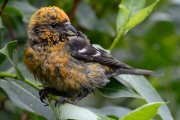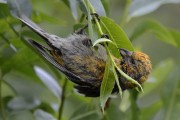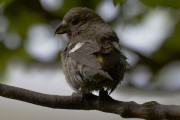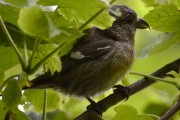Two-barred Crossbills – Halligarth, Unst, Shetland
Posted by Brydon Thomason on Sunday 11th December 2011 | Birding in Shetland
Late July has never really been a time that I have the time to be inspired from a birding perspective. It is a very busy period for me as our holiday and tour season is in full swing and I tend to spend most of it tracking Otters with photographers working long hours. However July is a month that can certainly produce the goods.
The 29th was the first of a very welcome couple of days I had off from guiding as we had friends visiting. As I was up well before our son Casey I thought I’d treat myself to my morning circuit, which when possible during migration seasons is my daily pre breakfast routine but due to various commitments I hadn’t been in the Sycamores for over a week.
Not surprisingly, my circuit of the sycamores had produced nothing and I hadn’t really expected it to, even the summering Chaffinch and Redwing were not to be seen. But just as I was about to leave ‘the wood’ movement in the canopy of leaves above caught my eye. I lifted my bins to catch a glimpse of a bold clean white wing-bar, maybe even two, flash in view through the movement of leaves. For a split second I thought it must be the female Chaffinch, but even though I hadn’t even seen any more than a bit of a wing bar, something appeared very different.
I side stepped a few feet with my bins still raised to my eyes and looking at where the movement had been. Then suddenly the bird swung rather clumsily upside down, hanging from a branch and in full view, “Two-barred bill” I exclaimed! Yes, I spoke to myself! Just 20 feet or so from me was a female Two-barred Crossbill, rather lethargically feeding amongst the leaves. She flew a short distance and landed, again under the shade of the dense canopy of Sycamore leaves. In flight the double bold white wing bars were striking as was her bright lemon rump which contrasted with the rest of her otherwise dull greyish overall plumage. I watched her for a few more minutes before popping back next door to fetch my camera and put the news out.
Catching up over the phone with some of the lads later in the morning I was surprised to hear of the movements of TBC’s westward across northern Europe and that a prospective ‘invasion’ looked to be well on the cards.
She was enjoyed by a handful of birders that day and next (including our guests Dave, Jenny and Rory Suddaby). To my surprise on the evening of the 30th I was delighted to find she had been joined by another, a first year male!
Having been totally silent for nearly two days, only now did there appear to be any calls. I had been vexed for her not to have called as I had fond memories of the 2008 invasion and one of the Fetlar birds I had found and how vocal it had been amongst Common Crossbills. Once heard, their diagnostic and rather nasal and metallic mewing call note is unlikely to be forgotten.
Apparently rather typical of the species, whilst feeding amongst and essentially below the canopy they were rather laboured in their movements and often without any calls until they flew and often appeared to prefer to keep at a fairly low level in the trees. This behaviour did not appear to be associated with an elusive nature however as it was often possible to view them down to just a few feet, totally oblivious to their admirers.
Interestingly the predicted movement across northern Europe did not appear continue to reach British shores. Two others however were found in Shetland later in the month, one of which found by SN team member Rob Fray on Sumburgh Head.
This was of course I hope and assume a good thing as it surely meant they found the food they favour in evergreen larch forests without crossing the North sea.





